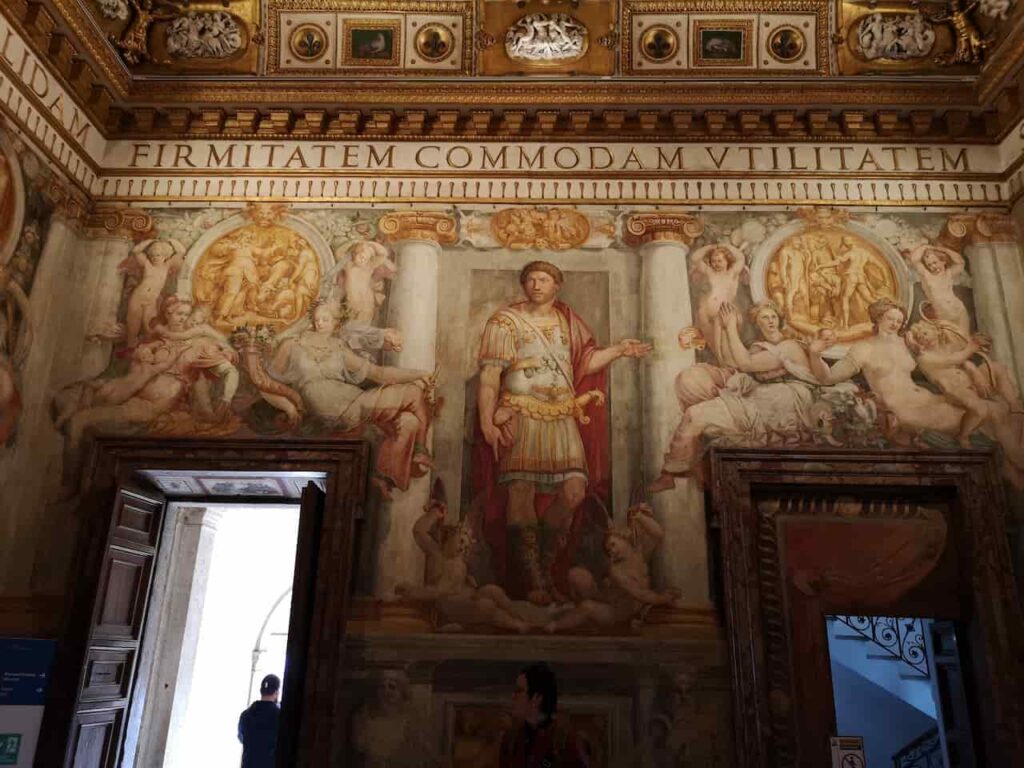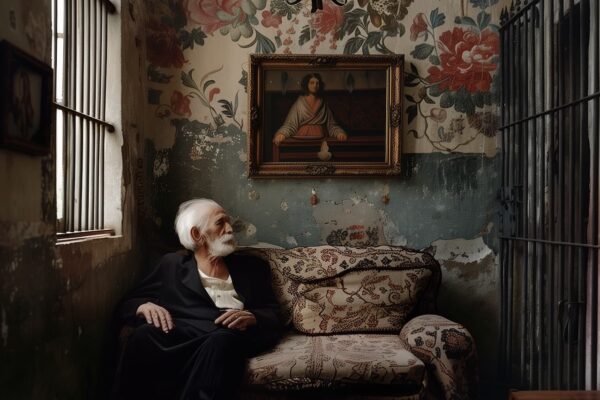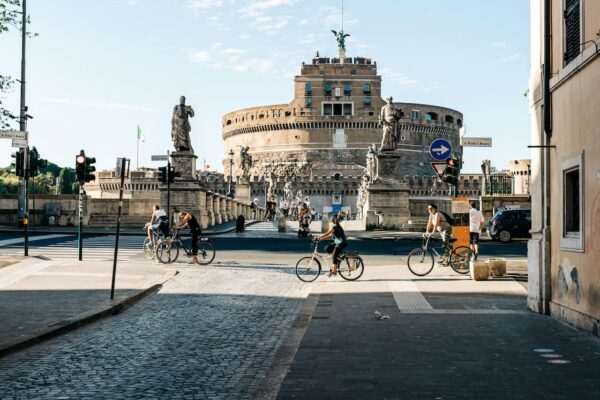If you are curious to learn more about the wonders of the Sala Paolina (or Pauline Hall) of Rome’s Castel Sant’Angelo, this post is for you.
In the following article, we will reconstruct together the history of one of the most beautiful rooms in Castel Sant’Angelo, alternating the description of the rooms with some in-depth information on the works of art that we can still admire today;
We will also move on to the smaller adjacent rooms, which are also splendid and full of works of art: the Hall of Perseus and the Hall of Cupid and Psyche;
So, are you ready to be amazed? Come on, follow me!
IMPORTANT! Before you start reading the article, I ask you to pay attention: given the popularity of this monument, to visit the Sala Paolina of Castel Sant’Angelo you will certainly encounter a long queue at the ticket office. To enter this attraction and skip the queue, I recommend the online ticket purchase. Click below to book your entrance and enter Castel Sant’Angelo without any loss of time.

Castel Sant’Angelo Rome Tickets: Quick Access
Buy online. Choose your preferred time. Visit Rome’s Castel Sant’Angelo, Hadrian’s Tomb, the fortress and much more.
You can cancel free of charge up to the day before the visit.
Pauline Hall: History and Description
Contents
Ascending from the Loggia di Giulio II you will find yourself in the marvellous Sala Paolina, the personal salon of Pope Alessandro Farnese, or Paolo III, whose name it still bears today.
Before you, emperors, kings, ambassadors and consuls from all over the world were hosted here. Not only that, but the room’s decorative ensemble represents one of the greatest artistic episodes of 16th century Rome.
For Paul III it was important that anyone entering should immediately get an idea of the grandness of his pontificate, of his power. The work of decoration of the room was entrusted to Perin del Vaga, who carried it out between 1545 and 1547 with the help of a number of illustrious collaborators, including Pellegrino Tibaldi, Luzio Luzi, Domenico Rietti and Giacomo Bertucci.
The frescoes, according to the pontiff, were to depict scenes from the lives of his “namesakes” Alexander the Great and St Paul, episodes that would be linked to his own existence and that, through their depiction, would have the function of celebrating it. Let us now see together what we can admire upon entering this hall.
The vault is very rich: in the centre is the stemma of Paul III and all around a complex of grotesque panels, stuccoes, papal emblems and cartouches in Greek, bearing witness to the humanistic culture of the pontiff. Six fresco panels, by Marco Pino, depict important episodes from the life of Alexander the Great.

Beneath the cornice, along all four sides of the rectangular room, runs a inscription in Latin celebrating the restoration of the old Mole Adriana and the construction of the Papal Residence.
On the walls we find a finished architecture, composed of Ionic columns and niches housing allegorical figures of the Cardinal Virtues of Strength, Justice, Temperance and Prudence. These are alternated with panels depicting other Stories of Alexander the Great, while on the doors we find illustrations of six Stories of St Paul.

In the centre of the short, majestic walls are frescoed portraits of Emperor Hadrian and Archangel Michael sheathing his sword, tributes to the founder and Christian protector of the place respectively, by Girolamo Siciolante da Sermoneta and Pellegrino Tibaldi.
The floor that we see today is more recent. The original terracotta one, in fact, was replaced in the 1820s by Innocent XIII, whose Papal crest still stands out in the centre.
The choice of painted scenes responds to a specific communicative plan implemented by the pontiff. The episodes, in fact, allude to the qualities of his rule, which is thus linked to that of the Macedonian emperor, while the choice of the martyr St. Paul puts the Christian spirituality of the Church of Rome back at the centre, at a time when it was conflicted with the Protestant world.
The generally solemn tones of the room’s decorative apparatus are mitigated by two trompe-l’oeil doors from which a courtier (according to some, the architect Antonio da Sangallo il Giovane) and servants descend a staircase with a basket of fruit;

And where we would least expect it, that is, right under the portrait of St. Michael the Archangel, two baboons pop up: according to some, in memory of a tribute from some foreign ambassadors to the pontiff, and according to others, to suggest the name of the author Giacomo Bertucci, as a signature.

Castel Sant’Angelo Rome Tickets: Quick Access
Buy online. Choose your preferred time. Visit Rome’s Castel Sant’Angelo, Hadrian’s Tomb, the fortress and much more.
You can cancel free of charge up to the day before the visit.
Sala Paolina Rome: the Adjacent Rooms
From the Pauline Hall, more precisely on the long wall opposite the windows, a door opens into the two private rooms of the pope;
These rooms are named after the characters depicted in the splendid frescoes that adorn the wall friezes, the work of Perin del Vaga: they are the Room of Perseus and the Room of Cupid and Psyche.
Follow me if you want to know more about these two fantastic environments!
La Sala di Perseo

The Sala di Perseo was the study of the pontiff Paul III. The ceiling and the upper part of the walls were decorated by Perin del Vaga and his large and prestigious team;
The ceiling is in cassettes, with grotesque motifs and heraldic symbols; in the centre stands, in relief, the figure of St. Michael the Archangel;
While in the Fregium it is Perseus who takes centre stage. With six large panels, the fresco depicts many of the Greek hero’s exploits from Ovid’s Metamorphoses;
The scenes are set in a fake architecture of frames and corners, with fruit festoons, masks and flowers;
Alternating with panels depicting Perseus are monumental maidens with unicorns, emblems of the Farnese family;
The mythological cycle should be “read” from the left of the entrance, where we find the “Hero’s Farewell to his Mother Danae” and “Perseus Receiving the Gifts of Mercury and Minerva“, and then proceeding clockwise to the last episodes at the door of the Sala Paolina: “The Return of Perseus“, “The Origin of Coral” and the “Nuptial Banquet of Perseus and Andromeda“.
Even behind the choice of these deeds, the pontiff reveals an important communicative strategy. The mythical hero who defeats Medusa is in fact the bearer of a message: the intellect is destined to prevail over the strong>strong irrational forces. In this, Paul III sees a clear metaphor for the struggle between the Church of Rome and the Lutheran Reformation, which he undertook with the Council of Trent.
Today, in the room we can also admire a part of the rich collection of works from Castel Sant’Angelo, including the ‘Christ Blessing‘ and the ‘St. Onofrio‘ by Carlo Crivelli, the ‘St. Jerome‘ by Lorenzo Lotto and the ‘Lamentation over the Dead Christ‘ by an unknown author.
The room communicates with the Bathroom of Clement VII below and the pontiff’s adjoining bedroom, the Room of Cupid and Psyche, which we will visit in the next section.
The Hall of Cupid and Psyche

Here we are in the bedroom of Paul III Farnese. A more intimate room than the previous ones, but no less precious;
Again, the decoration of the ceiling and walls was entrusted to Perin del Vaga. The cassette ceiling, with grotesques on a gold background and lilies alternating with targets with the pontiff’s name, has at its centre, in relief, the great Farnesian coat of arms;
On the fregio, framed by false corbels and curtains, we find nine panels depicting as many episodes from the fable of Cupid and Psyche as narrated in Apuleius’ The Golden Ass, to which is added a tenth scene, painted above the window;
The panels alternate with large winged victories and panels with grotesques on a gold background;
The scandalous presence of such a sensual story must be explained by reading the fable through the eyes of the pontiff who, with his strictly neo-Platonic culture, gave it a strongly allegorical reading in a Christian key;
Many of the individual episodes, in fact, see Psiche – that is, the soul – on a difficult and treacherous path to eternal salvation;
However, the sensuality of the tale remains explosive in scenes such as ‘Psiche discovers Love and Love flees‘, the most famous of the entire cycle.
In addition to the splendid frescoes, the room currently houses important works such as Christ Carrying the Cross by Paris Bordon and The Bath by Giovanni Luteri, known as Dosso Dossi.
The Pauline Hall of Castel Sant’Angelo: How to Visit It
To visit the Sala Paolina you only need to purchase a entrance ticket to the National Museum of Castel Sant’Angelo;
The entrance ticket alone, in fact, guarantees access to this area which, except for specific maintenance work, is normally open to visitors.
To reach the chamber, one must ascend through the helical staircase that leads from the Outside Courtyard to the Hall of Urns, and then proceed through the diameter staircase that crosses it. Once you have reached the Angel’s Courtyard, you will have to cross it, climb up to the Loggia of Julius II and take a few more steps.

The visiting hours are naturally linked to the opening hours of the National Museum of Castel Sant’Angelo, i.e. Tuesday to Sunday, from 9.00 to 19.30 with last admission at 18.00.
What are you waiting for? Are you ready to visit the Sala Paolina of Castel Sant’Angelo too? Read on to find out the best tickets to visit it.
Sala Paolina: Tickets
Unlike other areas of Castel Sant’Angelo, the Sala Paolina can also be visited without the accompaniment of an official guide;
However, it is possible – and in many ways advisable – to book an audio-guided visit or a guided tour of the castle.
Here you can access our selection of the best tickets you can buy online. I’m sure you’ll find the one that’s right for you!

Castel Sant’Angelo Rome Tickets: Quick Access
Buy online. Choose your preferred time. Visit Rome’s Castel Sant’Angelo, Hadrian’s Tomb, the fortress and much more.
You can cancel free of charge up to the day before the visit.
Pauline Hall of Castel Sant’Angelo: FAQ
Castel Sant’Angelo takes its name from St. Michael the Archangel who, according to tradition, in 590 A.D. appeared before Pope Gregory the Great on the top of the Mole Adriana in the act of sheathing his sword, prophesying the end of the plague epidemic that was afflicting the city.
Inside the Castel Sant’Angelo you can still admire the Tomb of Hadrian, the spiral staircase, the papal quarters, the frescoes, the execution ground, the Grand Loggia, the ramparts, the well-preserved fortress rooms and much more.
Admission is free every first Sunday of the month, and on free admission days there is no need for reservations.
A visit of Castel Sant’Angelo lasts an average of 1,5 hours, but if there are temporary exhibitions, or if you are an art lover, you may take more time to visit the Museum.
Pauline Hall of Castel Sant’Angelo: Conclusions
And here we are at the end of this in-depth article on the prestigious Sala Paolina and the adjacent Sala di Perseo and Sala di Amore e Psiche;
In this post I wanted to tell you the history of these important rooms and tried to describe them in all their beauty;
We talked about Paul III Farnese, his struggle to re-establish the centrality of the Church of Rome in the Christian world, and how this was reflected in the choice of decoration of halls;
I revealed the message behind the allegories of Alexander the Great, St Michael the Archangel, Perseus, Love and Psyche;
Moreover, I cast a fleeting glance with you at the many works of art that we now find exhibited in these beautiful rooms;
To conclude, as always, I have given you some brief useful information about the visit and tickets, and I have devoted myself to answering the most frequently asked questions so that you can be well prepared for your visit to Castel Sant’Angelo and the Sala Paolina. If you need more information, please leave a comment below; if you would like to visit the Castle and the Sala Paolina, purchase your ticket and skip the queue at the ticket office.


